Computer Hardware Store Database Er Diagram
The DBMS can be classified according to the number of users and the database site locations. These are:
On the footing of the number of users:
The database system may be multi-user or single-user. The configuration of the hardware and the size of the organization will determine whether it is a multi-user arrangement or a single user system.
In single user system the database resides on one estimator and is but accessed by one user at a time. This ane user may design, maintain, and write database programs.
Due to big amount of data management well-nigh systems are multi-user. In this situation the information are both integrated and shared. A database is integrated when the same information is non recorded in two places. For case, both the Library department and the Account department of the higher database may need student addresses. Even though both departments may access unlike portions of the database, the students' addresses should only reside in one place. It is the job of the DBA to brand certain that the DBMS makes the right addresses available from 1 key storage area.
On the basis of the site location
We'll be roofing the following topics in this tutorial:
Centralized Database System
The centralized database arrangement consists of a single processor together with its associated data storage devices and other peripherals. It is physically confined to a single location. Data can be accessed from the multiple sites with the use of a estimator network while the database is maintained at the primal site.
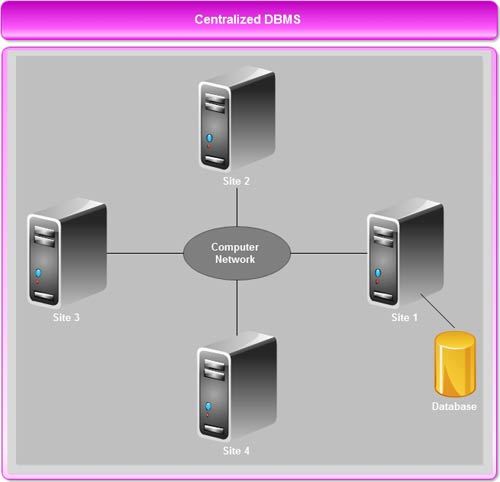
Disadvantages of Centralized Database System
• When the primal site computer or database organisation goes downwardly, and then every 1 (users) is blocked from using the system until the system comes back.
• Advice costs from the terminals to the primal site tin be expensive.
Parallel Database System
Parallel database organization architecture consists of a multiple Fundamental Processing Units (CPUs) and data storage disk in parallel. Hence, they improve processing and Input/Output (I/O) speeds. Parallel database systems are used in the awarding that have to query extremely large databases or that have to process an extremely large number of transactions per 2nd.
Advantages of a Parallel Database System
• Parallel database systems are very useful for the applications that have to query extremely large databases (of the order of terabytes, for example, 1012 bytes) or that have to procedure an extremely large number of transactions per second (of the order of thousands of transactions per second).
• In a parallel database system, the throughput (that is, the number of tasks that can be completed in a given fourth dimension interval) and the response fourth dimension (that is, the amount of fourth dimension it takes to consummate a single task from the time it is· submitted) are very high.
Disadvantages of a Parallel Database System
• In a parallel database system, there· is a startup cost associated with initiating a unmarried process and the startup-fourth dimension may overshadow the actual processing time, affecting speedup adversely.
• Since process executing in a parallel system frequently access shared resources, a slowdown may result from interference of each new process every bit it completes with existing processes for commonly held resource, such as shared data storage disks, system charabanc and so on.
Distributed Database System
A logically interrelated collection of shared data physically distributed over a computer network is called as distributed database and the software organization that permits the direction of the distributed database and makes the distribution transparent to users is called as Distributed DBMS.
It consists of a single logical database that is split into a number of fragments. Each fragment is stored on 1 or more computers under the command of a separate DBMS, with the computers connected by a communications network. Every bit shown, in distributed database system, data is spread across a variety of dissimilar databases. These are managed by a variety of unlike DBMS software running on a variety of dissimilar operating systems. These machines are spread (or distributed) geographically and connected together by a multifariousness of communication networks.
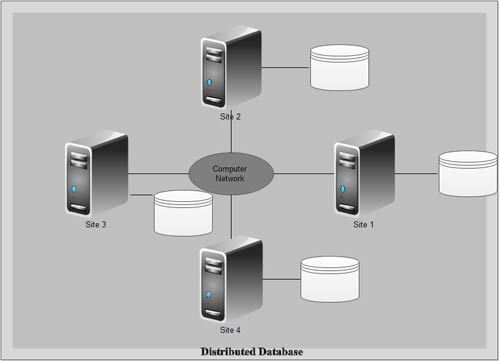
Advantages of Distributed Database System
• Distributed database architecture provides greater efficiency and amend performance.
• A single database (on server) can exist shared across several distinct client (application) systems.
• As data volumes and transaction rates increase, users can grow the system incrementally.
• It causes less impact on ongoing operations when adding new locations.
• Distributed database arrangement provides local autonomy.
Disadvantages of Distributed Database System
• Recovery from failure is more complex in distributed database systems than in centralized systems.
Client-Server DBMS
Client/Server architecture of database organization has two logical components namely client, and server. Clients are generally personal computers or workstations whereas server is large workstations, mini range figurer system or a mainframe reckoner system. The applications and tools of DBMS run on 1 or more than client platforms, while the DBMS soft wares reside on the server. The server computer is caned back end and the client's figurer is called front end end. These server and client computers are connected into a network. The applications and tools act as clients of the DBMS, making requests for its services. The DBMS, in plough, processes these requests and returns the results to the client(s). Client/Server architecture handles the Graphical User Interface (GUI) and does computations and other programming of involvement to the cease user. The server handles parts of the job that are common to many clients, for example, database admission and updates.
Multi-Tier client server calculating models
In a single-tier system the database is centralized, which ways the DBMS Software and the data reside in one location and the dumb terminals were used to access the DBMS as shown.
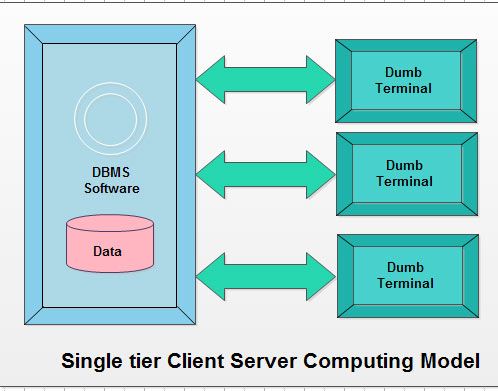
The ascent of personal computers in businesses during the 1980s, the increased reliability of networking hardware causes Two-tier and Three-tier systems became mutual. In a 2-tier system, different software is required for the server and for the client. Illustrates the two-tier client server model. At the early stages client server calculating model was called two-tier-computing model in which client is considered as data capture and validation tier and Server was considered as information storage tier. This scenario is depicted.
Issues of ii-tier architecture
The need of enterprise scalability challenged this traditional two-tier client-server model. In the mid-1990s, as application became more circuitous and could be deployed to hundreds or thousands of end-users, the customer side, now undergoes with following problems: 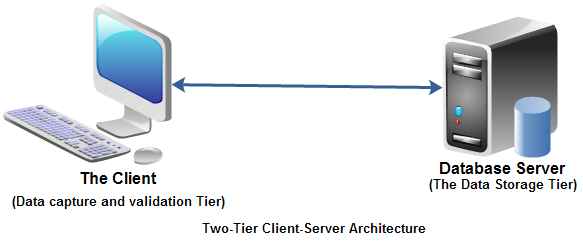
• A' fat' client requiring considerable resources on client's figurer to run effectively. This includes deejay space, RAM and CPU.
• Client machines require administration which results overhead.
Iii-tier architecture
By 1995, three-tier architecture appears every bit improvement over two-tier architecture. Information technology has iii layers, which are:
• First Layer: User Interface which runs on end-user's reckoner (the client) .
• Second Layer: Application Server Information technology is a business concern logic and data processing layer. This middle tier runs on a server which is called every bit Application Server.
• Third Layer: Database Server It is a DBMS, which stores the information required past the centre tier. This tier may run on a separate server called the database server.
Every bit, described earlier, the client is at present responsible for awarding'south user interface, thus it requires less computational resources now clients are called as 'thin customer' and information technology requires less maintenance.
Advantages of Client/Server Database Organisation
• Client/Server system has less expensive platforms to back up applications that had previously been running only on big and expensive mini or mainframe computers
• Client offer icon-based menu-driven interface, which is superior to the traditional command-line, dumb final interface typical of mini and mainframe reckoner systems.
• Client/Server environment facilitates in more productive work past the users and making better utilize of existing data. 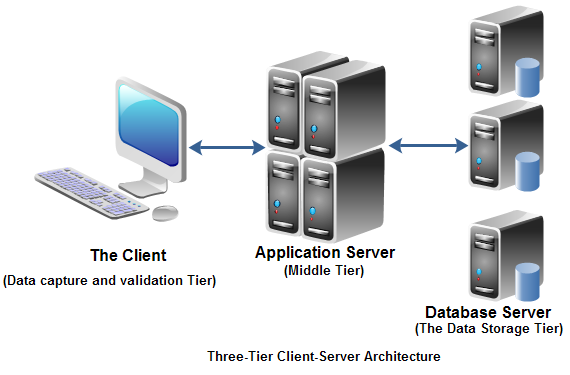
• Client/Server database organisation is more flexible as compared to the Centralized system.
• Response fourth dimension and throughput is high.
• The server (database) motorcar can exist custom-built (tailored) to the DBMS part and thus can provide a better DBMS performance.
• The customer (application database) might exist a personnel workstation, tailored to the needs of the stop users and thus able to provide better interfaces, loftier availability, faster responses and overall improved ease of use to the user. + A single database (on server) tin can be shared across several distinct client (application) systems.
Disadvantages of Client/Server Database Arrangement
• Programming cost is high in customer/server environments, particularly in initial phases.
• At that place is a lack of management tools for diagnosis, performance monitoring and tuning and security control, for the DBMS, client and operating systems and networking environments.
0 Response to "Computer Hardware Store Database Er Diagram"
Post a Comment